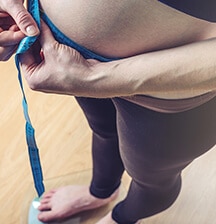
Why do we get stretch marks, and what (if anything) can we do about them?
Stretch marks – most pregnant women get them, and although few seem to be happy about them, they’re known as “tiger stripes” for a reason. Stretch marks are a visible reminder of what your amazing body has done to grow and nurture your baby, which may or may not make you feel better about their appearance during pregnancy. But what are stretch marks, exactly, and is there anything you can do about them?
What are stretch marks?
Also known as “striae gravidarum”, pregnancy-related stretch marks are essentially scars that appear in places on your body where the skin is stretched beyond its elastic limit (which physicists define as the maximum force that can be applied to a solid material before the onset of permanent deformation – pretty scientific, right?). Stretch marks appear when your underlying tissue expands (like when you’re growing a baby) and the skin above stretches to accommodate this expansion. Stretch marks usually appear on your abdomen and breasts, and also on your thighs and buttocks – almost anywhere that the skin is stretching beyond its usual capacity. They often look like bluish or reddish streaks.
How do I know if I’ll get stretch marks during pregnancy?
Over 90% of pregnant women develop stretch marks. There are a number of factors involved in determining whether you’ll get stretch marks, and how visible they might be. Generally speaking, the younger you are, the more firm your skin is, and this means the elastic limit of your skin is lower – so you are actually more likely to develop stretch marks if you’re a young mum-to-be. Hormones and genetics also have something to do with it. If you develop stretch marks on your breasts as an adolescent, you’re more likely to develop stretch marks on your abdomen during pregnancy. Also, women who gain more weight during pregnancy or who have bigger babies are also more likely to get stretch marks. One study demonstrated that weight gain over 15kg, high BMI, and higher neonatal birth weight were correlated with the occurrence of stretch marks. Other factors include being pregnant with twins or multiples, and going past your due date. But nearly 45% of women develop stretch marks before 24 weeks, so don’t be alarmed if they show up early.
What can I do about stretch marks?
Pregnant women throughout the ages have tried various remedies in the hopes of preventing stretch marks. The ancient Greeks and Romans used olive oil, while Ethiopians and Somalis used frankincense. The Japanese use camellia oil. Other natural remedies include aloe vera, apricot oil, macadamia or almond oil, cocoa butter, or coconut oil. Some specially formulated creams and stretch mark products may help to fade their appearance even if they can’t prevent them. Post-pregnancy, some women try laser treatments and microdermabrasion to try to fade the appearance of stretch marks. It’s important that whatever remedy you do try, you only use quality products, and you consult a professional before embarking on something that might potentially be irritating to your skin or damaging to your body.
Will my stretch marks always be so obvious?
While some stretch marks stay red or pink, most do eventually fade to white and become less conspicuous in appearance. And take heart that many women who develop stretch marks during their first pregnancy don’t get them in subsequent pregnancies, although never say never. Try to find a way to learn to love your tiger stripes and look at them as evidence of the incredible journey your body has been on during pregnancy and birth, and wear them as a badge of honour!








